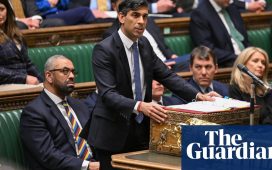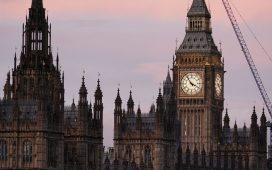One of the UK’s most senior medical leaders lauded “green shoots” of recovery from the coronavirus crisis, even as the daily death toll hit a record 381 and experts questioned whether the government has a credible route out of the lockdown.
Speaking in No 10, Stephen Powis, the medical director of NHS England, said there had been a “bit of a plateau” in the number of people testing positive for coronavirus, which could be a sign that the UK is seeing a slowdown in its spread.
He gave his assessment at a press conference alongside Michael Gove, the Cabinet Office minister, who said it was “deeply shocking, disturbing, moving” that 381 people had died in a day. The latest figures take the total UK death toll from coronavirus to 1,789.
Among the deaths was a 13-year-old boy from London, the UK’s youngest victim of coronavirus. He reportedly had no underlying health conditions.
“Sadly, a 13-year old boy who tested positive for Covid-19 has passed away, and our thoughts and condolences are with the family at this time,” King’s College hospital said in a statement.
“The death has been referred to the coroner and no further comment will be made.”
New figures showed an additional 40 previously unreported coronavirus deaths in England and Wales earlier this month. The new backdated figures, published by the Office for National Statistics, suggest that almost one in four coronavirus deaths are occurring outside hospitals, so went uncounted in data published by NHS England.
Despite the highest day for deaths since the crisis began, Powis said there was some cause for hope that social distancing is working, because of the relatively flat numbers of people testing positive for coronavirus.He cautioned that there were “green shoots – but only green shoots and we must not be complacent and we must not take our foot off the pedal.”
It came amid increased pressure over the failure to carry out mass testing, which some public health experts believe is the only sensible way to ease lockdown conditions. Daily testing stood at just over 8,200 on Tuesday, short of the 10,000-a-day target.
Public health academics told the Guardian that widespread testing in the community – not just in hospitals and among NHS workers – was necessaryto suppress new hotspots.Gove said there were shortages of chemical reagents used for testing live cases of the virus.
However, the Chemical Industries Association told ITV it was not aware
of any shortages and was contacting Gove’s office to find out what he
meant.
The difficulty of obtaining tests was underlined by the Welsh government’s admission that a private company had pulled out of a contract to provide 5,000 tests daily, leaving Wales only able to carry out 800 tests a day.
One Whitehall insider concerned about the government’s strategy told the Guardian that there were two barriers to more testing – firstly that the UK had been too slow to order tests, and secondly that government experts are still privately “counting on herd immunity” as a way out of the crisis, despite ministers’ denials.
The source said the fact that the government keeps talking about the possibility of an antibody test to show whether someone is immune shows ministers are still thinking about herd immunity.
Matt Hancock, the health secretary, insisted on March 15 that herd immunity was “not a part” of government strategy. But as recently as March 24, Jo Churchill, a health minister, said in a written answer to parliament that it was still part of the government’s expectations. “Herd immunity is not part of the government action plan but is a natural by-product of an epidemic,” she said.
Dr Jenny Harries, the deputy chief medical officer, appeared to confirm that the UK is still hoping for a large degree of immunity among the public to help lead to an easing lockdown measures. The alternative would be a strategy of suppressing the virus where it arises through rigorous testing and quarantining, as seen in South Korea.
“The have-you-had-it test is the secret to the secret to the answer about the lockdown,” she told the government press conference. “If we know how many people have had it, then we will understand the proportion of the population that could still get it. That gives us the clue to a number of things. For example, if we are to develop a vaccine, we can know how many people we need to immunise. If we are going to take lockdown measures off, we can model to say we know this proportion of the population is still likely to get the disease, so what happens to the second spike if we take them off…
“There are other scientists testing cohorts… so we can start to get an idea how many people in the population have had it. That is more of a clue to managing the end of the outbreak and when we can take the locks off.”
Several public health academics challenged the government’s strategy. Prof Nicola Stonehouse, an expert in molecular virology at the University of Leeds, said: “We should test for virus and exposure in the public. If we have that information we can have a more sensible approach about moving back to normality.
“If we can’t get the perfect reagent or set of reagents do we do nothing, or say let’s use something else? That’s where things have jammed up. Other countries are working around that. We have to be more creative.”
Devi Sridhar, professor of global public health at University of Edinburgh, also said: “Everyone in quarantine [is] not sustainable. It’s really expensive economically and socially. There has to be a safe way out of lockdown and I can’t see any other way than mass testing. We have to figure out who has the virus, who they are around, and change it so only they are in quarantine. Lockdown is a very blunt tool, it’s not precise. If they can’t do the testing they should just come out and say it.”
She said both tests of live cases and an antibody test – to show who has had the virus – were needed.
Amid the concerns about testing, there appeared to be better news on ventilators, as Gove revealed that the first newly-commissioned devices will roll off the production line this weekend and be delivered to the NHS next week.
Gove also confirmed that three RAF Puma helicopters are now stationed at Kinloss Barracks in Moray – working with a Chinook and Wildcat helicopter based at RAF Leeming in North Yorkshire – to meet requests for assistance from NHS boards and trusts across Scotland and Northern England.
They have been made available to evacuate critically ill patients as well as moving equipment and medical personnel around the country.














